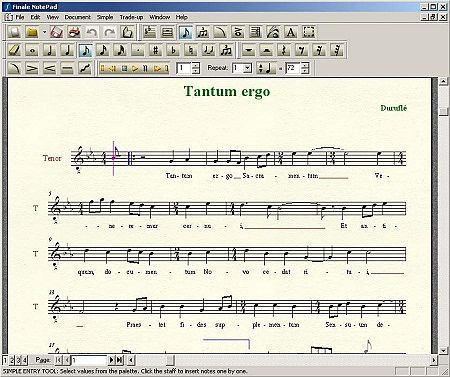Finale, the world standard for music notation software, lets you compose, arrange, notate, and print engraver-quality sheet music. Spin Robert Charles Wilson Epub here. Finale NotePad 2003 (FinaleNotePad.EXE). Finale NotePad is an application that lets you compose, arrange or transpose music scores for different.
Dutch, English, French, German, Italian, Japanese, Polish, Swedish Website Finale is the flagship program of a series of software developed and released by MakeMusic for the and operating systems. First released in 1988, the version 25 was released in 2016. Finale has been regarded as one of the industry standards for music notation software. Finale is one of a number of types of used by, and for creating, including the score for an entire ensemble (e.g.,,,, etc.) and parts for the individual musicians. Sony Str Vx250 Manual. A scorewriter is to what a is to text, in that they both allow fast corrections (via the ' button), flexible editing, easy sharing of content (via the Internet or compact ), and production of a clean, uniform layout. In addition, most scorewriters, including Finale, are able to use software-based to 'play' the sounds of the notated music and record the music—an especially useful feature for novice, when no are readily available, or if a composer cannot afford to hire musicians.
MakeMusic also offers several less expensive versions of Finale, which do not contain all of the main program's features. These include SongWriter, PrintMusic, and a program, Finale Notepad, which allows only rudimentary editing.

Discontinued versions include Finale Guitar, Notepad Plus, Allegro, and the free Finale Reader. Contents • • • • • • • • • • • • Appearance [ ] The default Untitled document is a 31- piece for a single instrument. A Setup Wizard, an alternative method of starting a project, consists of a sequence of dialogs allowing the user to specify the,,,, title, composer, and some aspects of score and page layout.
Finale's current default music notation font is Maestro. Functionality [ ] Finale's tools are organized into multiple hierarchically organized palettes, and the corresponding tool must be selected to add or edit any particular class of score element, (e.g., the Smart Shape tool to generate and edit lines and 'hairpins' (so-named because the symbols resemble ); the Staff tool to add and edit the parameters of individual staves). Alongside these tools, additional controls are available to view or hide up to four superimposed layers of music that can be entered onto any particular staff, for purposes of organizing multiple contrapuntal voices on the same staff. Several of Finale's tools provide an associated menu just to the left of the Help menu, available only when that particular tool is selected. Thus, the operation of Finale bears at least some surface similarities to. On the screen, Finale provides the ability to color code several elements of the score as a visual aid; on the print-out all score elements are black (unless color print-out is explicitly chosen).
